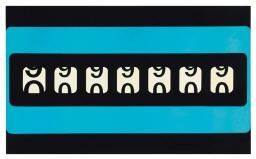The embroidered maps, wall-hangings, biro art and postal works of Alighiero Boetti (1940-1994) are on show in Naples in a new retrospective which its curator hopes will shed new light on one of the best-known figures in the Arte Povera movement.
The MADRE Museum is hosting the exhibition, which features a selection of works from different stages in the career and life of an artist defined by top critic Achille Bonito Oliva as ''a bit of a kleptomaniac''.
''He was an artist on the move and a bit of a kleptomaniac for his ability to pick up something from wherever he travelled: a small detail that became part of his being and his cultural makeup,'' said Bonito Oliva.
Entitled Mettere all'Arte il Mondo: 1993-1962 (Putting The World Into Art: 1993-1962), the exhibit moves backward through Boetti's career, starting with his later works, which embraced a collective sensibility, and ending on his earlier, more individualistic pieces.
Among the most striking works are an installation comprising 50 Afghan kilim rugs, set up in the museum's central hall, and a vertical bronze sculpture in the front courtyard, entitled Self Portrait, which plays with the relationship between the artist and nature.
Although usually associated with Arte Povera, Boetti is best known today for the collective works he completed during the later part of his career, after leaving the movement.
These pieces, many of which inspired by his extensive travels through Afghanistan and Pakistan, were the result of collaborative processes, in which artists and non-artists were invited to make their own contributions.
His large embroidered maps of the world were created with artisans from both countries, who completed the embroidery in their colour of choice. The political boundaries of the day were marked out by the various national flags, which covered the relevant country.
Another famous collection was his ''postal dossier'', a series of collages created from a variety of postage stamps.
In his Lavori Biro, he asked friends to draw what they wanted on large, coloured sections of his work using a ballpoint pen.
These pieces, using simple ballpoint pens, provided a link between his collective and Arte Povera works, involving multiple contributors using basic materials.
The use of modest materials, such as pens, in order to debunk traditional artistic approaches, was one aspect of Boetti's conception of Arte Povera.
However, earlier in his career he also experimented with many of the more unusual materials that were the traditional domain of the Arte Povera movement, such as plaster, plexiglass, plastics and industrial materials.
The final section of the exhibition looks at these more elemental works, which first fired Boetti when he left business school to explore his imagination through art.
The exhibition runs in Naples' MADRE Museum until March 11.
MADRE is an acronym for Museo d'arte contemporanea Donnaregina.








